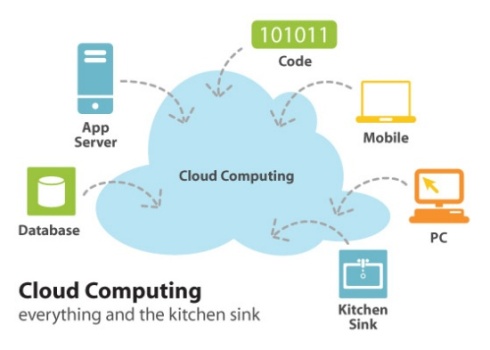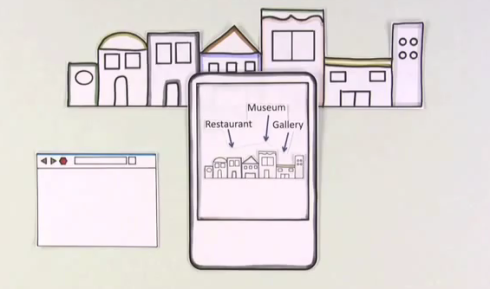After my recent post about Google’s attempt to eat Apple, I have been digging more and more into the sphere of the battle of IT giants, realizing that this topic is far more complex and intricate than expected. I soon was caught in the network and encountered ever more often following facts I need to portray first for elaborating purpose:
At first and this is well- known, (1) demand for energy- efficiency in future information and communication technologies ICT is constantly increasing. Since IT firms face higher energy costs as well as the need to reduce green house gas emissions, they now fight over the best energy- efficient technologies that decrease the overall energy consumption of computation, storage and communications.
Respectively, (2) Amazon has just launched the first cloud music service in March 2011. Cloud computing has been a central element to IT geeks for a long time. Now breaking it down for the ordinary citizen: How does cloud computing work?
 Before the era of cloud computing, music was usually saved on a computer’s storage system and processor. Now, music data is transferred to a remote data centre – the “cloud”, leaving users with an unlimited access to their data (compare this with the service of Dropbox). “Having access to your music on all your devices has to be the starting point of any next-generation music service and product,” says Mark Mulligan, an analyst at Forrester Research, ensuring Amazon a comparative advantage on the IT market.
Before the era of cloud computing, music was usually saved on a computer’s storage system and processor. Now, music data is transferred to a remote data centre – the “cloud”, leaving users with an unlimited access to their data (compare this with the service of Dropbox). “Having access to your music on all your devices has to be the starting point of any next-generation music service and product,” says Mark Mulligan, an analyst at Forrester Research, ensuring Amazon a comparative advantage on the IT market.
The two stories seem to be chosen arbitrarily, but by combining them I suddenly arrived at a completely new matter of discussion – the Green Cloud computing!
Can a cloud ever be green?
Johannes Baumgarter, Managing Director Austria of Fujitsu Technology Solutions, revealed last week that companies embracing cloud computing can manage to cut maintenance costs by 60% and energy costs by 30%.
This must be true for any device with limited capacity for data storage. The only thing necessary is a browser. Any further information is provided by the cloud. It is generally called a user’s service as David Carerra, one of the directors of the Cloud Computing (CC) team, explains: “It (cloud computing) is a system of selling software as a service. It is not the same as what we do now – for example, download from Microsoft, pay the license and own the software.” If the application is finished, its data will be brought back into the cloud and the app will be removed from the user’s device. As Rod Tucker, leader of the University of Melbourne research team concludes: “In this way, the user device is kept simple, energy- efficient and cheap.”
Respectively, many firms try to optimize their data centre operations by reducing their servers, relying on data sets from the cloud and therefore making their organization truly energy efficient. Still, we should not confuse efficiency with eco friendliness!
Efficiency against eco friendliness
This means that when comparing the energy consumption of cloud- based services, one has to always take into account the energy used for any data transportation from the user into the cloud and back. As the US Environmental Protection Agency estimated, power consumption of data centres is expected to double up to 1 % of US greenhouse gas production by 2020. Environmentalists also criticize organizations such as Facebook that tries to optimize its data centres by generating energy via coal- burning power plants. Their argumentation of green computing is therefore rather paradox.
The struggle out of the fog
I think that an evolution of sustainability is irreversible and the trend towards cloud computing does provide a basis for future developments. Still and I agree with Jordi Torres, coordinator of the CC research team, “the problem is that the increase in energy requirements is exponential, and there are no signs of a change in this trend”. Therefore firms, as cloud computing becomes more widespread, should improve their energy extraction by focussing on natural resources as Google already does by its Atlantic Wind Connection. If research and development is continuously upgraded, Green IT might soon be seen as anything else than a dense fog.
 So why not simply jump into the pool full of data, commands, and web complexity. The first information I came across while cyber diving was the WebWork PowerPoint provided by my professor Dr. Bruce. It basically was an introduction to various topics such as databases, templates, and plug- inns. If having to write about something complicated, I was more than happy to have the possibility to choose. And if so, why not choosing something I feel quite comfortable with – Cascading Style Sheets (CSS)! In general, CSS is a powerful web tool used to describe the formatting of a document written in a markup language (HTML, XML), or as Philipp Lenssen in a Quick Guide to Web Development summarizes: “CSS are the way to layout a page“!
So why not simply jump into the pool full of data, commands, and web complexity. The first information I came across while cyber diving was the WebWork PowerPoint provided by my professor Dr. Bruce. It basically was an introduction to various topics such as databases, templates, and plug- inns. If having to write about something complicated, I was more than happy to have the possibility to choose. And if so, why not choosing something I feel quite comfortable with – Cascading Style Sheets (CSS)! In general, CSS is a powerful web tool used to describe the formatting of a document written in a markup language (HTML, XML), or as Philipp Lenssen in a Quick Guide to Web Development summarizes: “CSS are the way to layout a page“!








